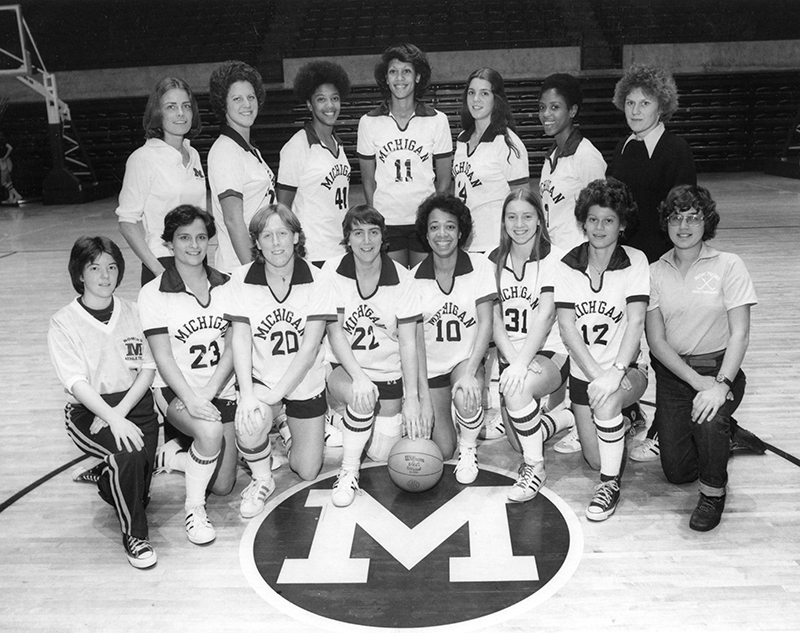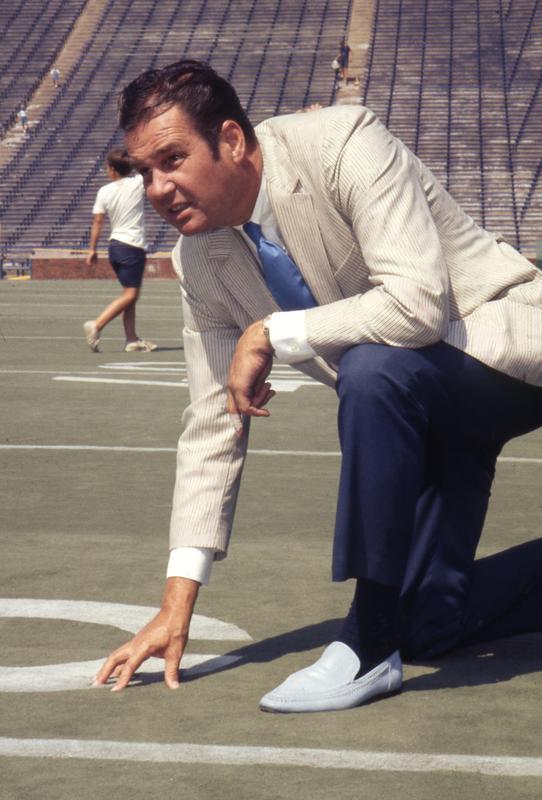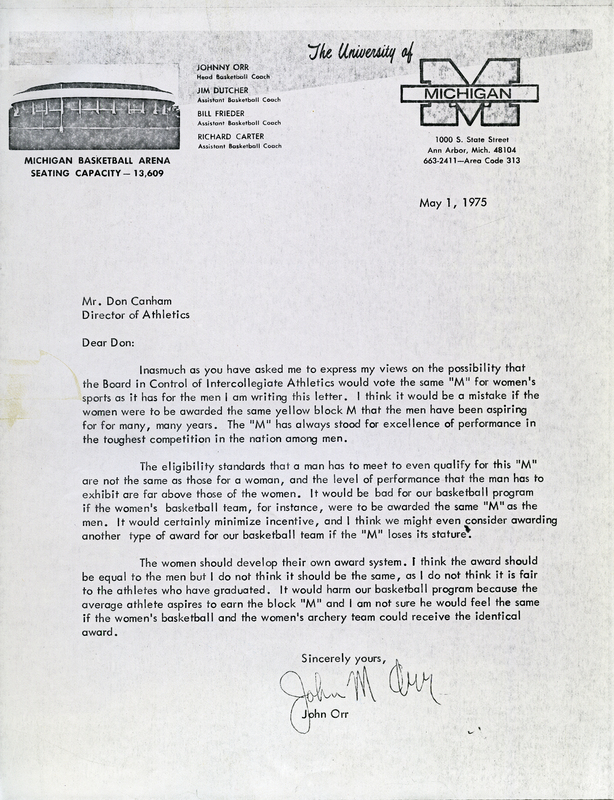This Is Standby Alert

University of Michigan women’s basketball team, 1977. [Bentley Historical Library, University of Michigan]
Shortly after President Gerald Ford approved Title IX’s application to collegiate sports in 1975, the Detroit Free Press published an interview with Don Canham, the University of Michigan’s athletic director. “I’m furious. I’m more than upset because it’s so absolutely stupid,” he said. “I’ve been to Washington. I hate to count the times I’ve been to Washington on Title IX. I just can’t quite comprehend something this ridiculous being shoved down our throats.” Canham had run the school’s athletic department for seven years at that point, and had spent many of those years attacking Title IX, the 1972 legislation prohibiting sex discrimination in federally funded educational programs. He also put his department in the black when so many others across the nation faltered during the dismal economy of the 1970s. Because of his success, the administration let him work without much oversight or complaints about his extracurricular advocacy work. The story of Canham’s activism and anger is a reminder of how intensely the movement against Title IX fought against change, and how the battle against it went all the way to the White House — and continued long after implementation began in 1975.
While serving as track coach at the University of Michigan, Canham built a multi-million-dollar business selling playground equipment to schools. He put his work on hold to run the Wolverine athletic department in 1968 but continued to deploy his marketing acumen in his new position. Canham’s model for a new type of athletic director soon became the norm across the United States. The revenue-generating sports of football and basketball drew most of his attention. Canham was the first athletic director to launch a ticket-mailing campaign and an advertising blitz with posters and bumper stickers. He elevated, if not invented, the art of tailgaiting, making gameday an event, while moving to the forefront of creating and licensing team related merchandise, all of which are now multi-million-dollar businesses.
As Canham framed it, his fears about women’s sports being a money pit were the reason he fought so hard against Title IX. Given the administrative freedom he enjoyed at Michigan, his annoyance about the prospect of more oversight undoubtedly contributed to his ire, as did sexism, given his lack of imagination about women athletes’ potential. Canham stated that he worried about the costs of providing an equal number of scholarships for men and women, along with commensurate funding in coaching, travel, and facilities. The application of Title IX to athletic departments, he complained, would mean “astronomical costs” that would “simply put us all on the shelf.” His campaign to prevent the regulations from applying to university athletic programs stalled implementation for well over the first decade of the policy’s existence. Scholar Kelly Belanger referred to this era as “The Invisible Years.”
The Title IX 50th Anniversary report, published by the National Collegiate Athletic Association (NCAA) in 2022, highlighted overall progress for women’s athletics while singling out areas of concern, including a 23 percent difference in total spending between men’s and women’s athletics programs amongst member institutions in Division I. The report documented how Canham’s assumptions about the unprofitability of women’s athletics were still alive and well among administrators. Yet, while the ink dried on the report, women’s sports were enjoying unprecedented television ratings, challenging such assumptions. With University of Iowa’s Caitlin Clark setting scoring records in front of sell-out crowds, and exciting rivalries such as South Carolina vs. Louisiana State, women’s basketball has continued to surge this season, building on the massive television numbers from last season’s Final Four. Interest in televised gymnastics and volleyball competitions also increased in recent years. A new round of March Madness and the elevated excitement surrounding the women’s tournament will reinforce the rationale of the new, eight-year, $920 million dollar deal giving ESPN exclusive rights to 40 championships in women’s athletics.

Don Canham inspecting artificial turf at Michigan Stadium, 1969. [University of Michigan. Athletic Department]
For historians wishing to study the history of collegiate sport, the Bentley Historical Library at the University of Michigan is a treasure trove. Over the 20th century, the University of Michigan had three successive, long-serving athletic directors — Fielding H. Yost, Fritz Crisler, and Don Canham, each leaving behind a large collection of personal papers complimenting a collection from the Board of Athletic Control. Together, these collections chronicle many trends in collegiate sport history, including the battle over the implementation of Title IX.
Though Title IX was passed by Congress in 1972, it took three years to establish and iron out the regulations. This allowed the NCAA to launch an offensive against the application of Title IX to athletic departments, The counteroffensive was led by longtime NCAA executive director Walter Byers who, in 1974, declared that unless Title IX was shut down, or least not applied to intercollegiate athletic departments, “the possible doom of collegiate sport is near.” In a May 1975 letter to Canham, Byers warned, “The disposition of Title IX regulations by President Ford is at the critical stage … In effect, this is standby alert.”
Title IX opponents wanted Canham on board because he was respected and bold in his approach — and because of his connections to the University of Michigan alumni network. While Ford, former center on the Michigan Wolverines — and the 1934 team’s Most Valuable Player — deliberated about whether to apply Title IX to intercollegiate athletic departments, the NCAA awarded him the Theodore Roosevelt Award, given to an outstanding citizen who graduated from an NCAA member institution and continues to uphold the virtues of physical fitness and competitive sport in “his” professional life. Canham, working with the NCAA, visited with White House lawyers, while sending Michigan’s football coach, Bo Schembechler, to talk directly to Ford. He leaned on Caspar Weinberger, Ford’s secretary of Health, Education, and Welfare, as early as April 4, 1974, writing, “It is of great concern to us that there be more input into this proposed implementation if we are to preserve intercollegiate athletics in anywhere near its present form.”
Canham’s correspondence within opposition circles grew increasingly despondent. On a May 1975 memo addressed to a “Joint Group” of detractors composed of NCAA officials and fellow athletic directors, he wrote, “In the back of our minds I believe we have all felt that the proposed Title IX guidelines were so ridiculous that someone, somewhere along the line would straighten them out so that intercollegiate athletics can survive. I am afraid that after talking with three of the White House lawyers for the better part of an afternoon I cannot be that optimistic.” The lawyers told Canham the situation was political and “half of the population (women) are involved” with lobbying groups, such as the National Organization of Women, running the best campaign they had ever witnessed.
President Ford announced in June 1975 that, after consultation with Weinberger, he would approve of the regulations of Title IX and they would be applicable to athletic departments. Though sympathetic to the concerns of the opponents of Title IX, Ford was ultimately not swayed.
Those organizing against the Equal Rights Amendment tried to enlist Title IX’s university-level opponents in a different, if related, policy battle. Elaine Donnelly, a leader of the STOP ERA movement in the state of Michigan and the national media chair of conservative activist Phyllis Schlafly’s think tank, reached out to the NCAA and Canham in 1975. In a letter to NCAA official John Fuzak, Donnelly included Canham on the correspondence, writing, “We need your help if the ERA is to be defeated again next year,” while arguing “the movement to STOP the ERA is the most successful movement in the country today.” As part of her ultimately successful strategy, Donnelly stoked fear that “sexually integrated teams” loomed just around the corner.
Meanwhile, Canham and his allies moved to stalling the now inevitable implementation of Title IX. Letters and memos in the Canham file indicate a strategy of foot dragging and continued hostility over the next decade. Close reading of Canham’s tone in letters and memos to Phyllis Ocker, the women’s athletic director tasked with building a program following Title IX, reveal rude and condescending remarks. Records also indicate Canham’s selectively parsing and presenting data in addressing the Title IX regulations. A 1976 study revealed sponsorship of seven women’s teams at the University of Michigan with 151 athletes compared to eleven men’s teams with 511 athletes. The women’s budget stalled at $160,000, while the men’s was well over $1 million dollars per year. Canham reasoned this was fine, pointing out that if football was exempt, the men would only receive 66 percent of the funding. Michigan’s affirmative action coordinator Virginia B. Nordby called Canham’s response “self-serving.”
In 1975, the animosity toward the growth of opportunity for women’s athletics even spilled over to the awarding of letters for athletic accomplishments. The University of Michigan lettermen took their name of “M Men” seriously, loudly protesting when the women asked to receive similarly embroidered jackets. Men’s basketball coach Johnny Orr wrote letters of protest to Canham, indicating men’s ‘M’ letters would be meaningless if women received the same for what he believed represented lesser levels of performance. Others affiliated with the university thought such complaints were embarrassing. Donors Ilze and Donald Koch threatened to cut off their annual gifts, writing, “Male chauvinism and eight-year-old boy mentalities have no place in a great university.”

Letter from John Orr to Don Canham, 1975. [University of Michigan. Athletic Department]
But for the most part, when Canham faced pushback at his institution for failing to treat women’s sports equally, it was easily subdued; the Board of Athletic Control and administration had little interest in challenging him, given the money he was bringing in while turning around the men’s revenue-generating sports. In 1973, student athletes Sheryl Szady and Linda Laird drew up a list of grievances and shortcomings — including lack of equipment, uniforms, practice and game space, travel support, and only being provided mostly volunteer coaches — presenting it to the executive office at the university. A decade later, many of the same issues remained. Similar battles took place across the country. At the University of Oregon, Becky Sisley, who served as the first women’s athletic director for the Ducks from 1973 to 1979, not only fought for change at her own institution, but also gathered articles and stories from across the country highlighting the push for implementation and adherence of Title IX regulations. This material was organized into an academic class she taught for the university. At the University of Iowa archives, the Christine Grant papers reveal the key role she played as an athletic administrator in Title IX cases and lawsuits.
Canham continued as a well-regarded athletic director into the 1980s, brokering television deals that further changed the landscape of collegiate athletics. In the process, he continued to hold a negative view toward investment in women’s athletics while continually criticizing Title IX’s regulations. When he was informed the Reagan administration hoped to cut back on the enforcement of Title IX regulations, Canham was overjoyed, arguing that women’s programs had little to worry about. (Although Reagan attempted to veto the Civil Rights Restoration Act of 1987, which would expand Title IX protections, Congress overrode the veto.)
Detroit Free Press journalist Nickie McWhirter immediately called Canham out. She knew women’s sports would suffer if Title IX was not vigorously enforced with federal backing. “I have a vision of the leopard telling the gazelle not to worry,” she wrote, adding, “Anybody who puts the fox on its honor then locks it up in the hen house all night is going to wake up with a lot of dead chickens.”
“This could be their opportunity,” warned McWhirter. Had her warning not been heeded, we can only wonder how much the damage that fox could have wrought throughout the landscape of college sports.